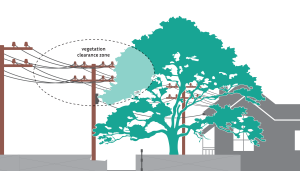We have an obligation to clear any vegetation that poses a risk to our assets. The Electricity Safety Act, including the Electrical Safety (Electric Line Clearance) regulations require us to meet certain minimum standards, including maintaining the clearance distances between trees and other vegetation near high voltage and low voltage powerlines.
We are responsible for maintaining trees:
- growing on private property which branch out near the main wires.
- on your property that impact your neighbour’s service wire.
- on certain nature strips across Powercor network (have a look at the diagram below to find out who is responsible in your area).
If we see trees on your property that need to be cut, we’ll leave a notification in your letterbox.










